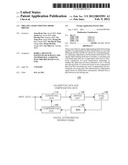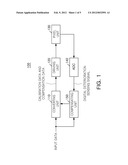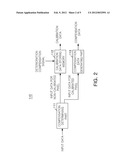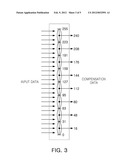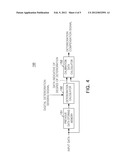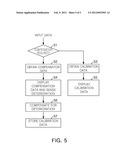Patent application title: ORGANIC LIGHT EMITTING DIODE DRIVER
Inventors:
Sang Hyun Cha (Seoul, KR)
Sang Hyun Cha (Seoul, KR)
Yeun Joong Lee (Seoul, KR)
Gyu-Hyeong Cho (Daejeon, KR)
Gyu-Hyeong Cho (Daejeon, KR)
Jin Yong Jeon (Daeju, KR)
Kyung Ho Lee (Ansan, KR)
Jun Hyeok Yang (Daegu, KR)
Jun Hyeok Yang (Daegu, KR)
Hyun Sik Kim (Jeonju, KR)
Jae Shin Lee (Anyang, KR)
Jae Shin Lee (Anyang, KR)
Assignees:
KOREA ADVANCED INSTITUTE OF SCIENCE AND TECHNOLOGY
Samsung Electro-Mechanics Co., Ltd.
IPC8 Class: AG09G500FI
USPC Class:
345690
Class name: Computer graphics processing and selective visual display systems display driving control circuitry intensity or color driving control (e.g., gray scale)
Publication date: 2012-02-09
Patent application number: 20120032991
Abstract:
There is provided an organic light emitting diode driver being capable of
compensating for pixel deterioration in real time during the driving of
pixels by selectively compensating pixels, requiring compensation, for
the deterioration thereof. The organic light emitting diode driver
includes a converting unit converting input data into compensation data
used to selectively compensate for pixel deterioration depending on
whether the input data has been calibrated or not; a driving unit driving
pixels of a pixel unit based on the compensation data from the converting
unit; and a compensating unit providing the converting unit with a
deterioration compensation signal based on deterioration information
obtained from a pixel driven by the driving unit.Claims:
1. An organic light emitting diode driver comprising: a converting unit
converting input data into compensation data used to selectively
compensate for pixel deterioration depending on whether the input data
has been calibrated or not; a driving unit driving pixels of a pixel unit
based on the compensation data from the converting unit; and a
compensating unit providing the converting unit with a deterioration
compensation signal based on deterioration information obtained from a
pixel driven by the driving unit.
2. The organic light emitting diode driver of claim 1, wherein the converting unit stores calibration data included in the deterioration compensation signal from the compensating unit and converts input data for a target pixel to be non-calibrated into calibration data corresponding thereto.
3. The organic light emitting diode driver of claim 2, wherein the converting unit comprises: a compensation determining part determining whether the input data has been compensated for or not, depending on whether calibration data corresponding to a target pixel to be driven by the input data is present or not; a calibration data storing memory providing calibration data corresponding to the input data based on a result of determination of the compensation determining part; and a compensation data generating part providing compensation data corresponding to the input data based on a result of determination of the compensation determining part.
4. The organic light emitting diode driver of claim 3, wherein the compensation data generating part has a plurality of predetermined gray scale ranges and provides the compensation data as a representative value of a gray scale range, to which a gray scale level of the input data belongs.
5. The organic light emitting diode driver of claim 1, wherein the compensating unit comprises: a previous data storing memory storing initial luminance data of a target pixel to be compensated or luminance data obtained by a previous compensation; a deterioration calculator calculating a degree of deterioration in the pixel by comparing deterioration information of the pixel with the luminance data from the previous data storing memory; and a calibration data calculator calculating calibration data adjusting a luminance of the pixel according to the degree of deterioration calculated by the deterioration calculator.
6. The organic light emitting diode driver of claim 5, wherein the calibration data calculator calculates the calibration data adjusting the luminance of the pixel to have a luminance equal to an average luminance of all of the pixels.
7. The organic light emitting diode driver of claim 1, further comprising an analog-to-digital converter (ADC) sensing a degree of deterioration in the driven pixel of the pixel unit and transmitting the deterioration information related thereto to the compensating unit.
8. The organic light emitting diode driver of claim 7, wherein the ADC senses a luminance value of the driven pixel.
9. The organic light emitting diode driver of claim 8, wherein the compensating unit comprises: a previous data storing memory storing initial luminance data and use time of a target pixel to be compensated or luminance data and use time thereof obtained by a previous compensation; a deterioration calculator calculating a degree of deterioration in the pixel by comparing deterioration information of the pixel with the luminance data and the use time thereof from the previous data storing memory; and a calibration data calculator calculating calibration data adjusting a luminance of the pixel according to the degree of deterioration calculated by the deterioration calculator.
10. The organic light emitting diode driver of claim 9, wherein the calibration data calculator calculates the calibration data adjusting the luminance of the pixel to have a luminance equal to an average luminance of all of the pixels.
Description:
CROSS-REFERENCE TO RELATED APPLICATIONS
[0001] This application claims the priority of Korean Patent Application No. 10-2010-0075881 filed on Aug. 6, 2010, in the Korean Intellectual Property Office, the disclosure of which is incorporated herein by reference.
BACKGROUND OF THE INVENTION
[0002] 1. Field of the Invention
[0003] The present invention relates to an organic light emitting diode driver, and more particularly, to an organic light emitting diode driver capable of compensating for pixel deterioration in real time during the driving of pixels by selectively compensating pixels, requiring compensation, for the deterioration thereof.
[0004] 2. Description of the Related Art
[0005] In recent years, in general display devices such as a cathode ray tube (CRT) and a liquid crystal display (LCD), with the increased demand for display devices achieving a reduction in volume while having a large size, much attention has been drawn to display devices employing an organic light emitting diode (OLED) having a response rate significantly higher than that of an LCD and reducing the size and weight thereof by approximately two-thirds as compared with those of the LCD.
[0006] This OLED is divided into a passive matrix organic light emitting diode (PMOLED) and an active matrix organic light emitting diode (AMOLED) according to a driving method. In particular, an AMOLED capable of individually controlling pixels, which are the smallest elements of an image processed in a display system, is commonly used.
[0007] Such an AMOLED is superior in terms of image quality, thickness, weight, brightness, power consumption, and the like, as compared with existing LCDs.
[0008] However, this AMOLED display may suffer from deterioration, deterioration being defined as the generation of an image having gradually lower luminance in response to the same data signal as a certain period of time elapses, and this may result in a failure to display an image having uniform luminance.
SUMMARY OF THE INVENTION
[0009] An aspect of the present invention provides an organic light emitting diode driver capable of compensating for pixel deterioration in real time during the driving of pixels by selectively compensating pixels, requiring compensation, for the deterioration thereof.
[0010] According to an aspect of the present invention, there is provided an organic light emitting diode driver including: a converting unit converting input data into compensation data used to selectively compensate for pixel deterioration depending on whether the input data has been calibrated or not; a driving unit driving pixels of a pixel unit based on the compensation data from the converting unit; and a compensating unit providing the converting unit with a deterioration compensation signal based on deterioration information obtained from a pixel driven by the driving unit.
[0011] The converting unit may store calibration data included in the deterioration compensation signal from the compensating unit and converts input data for a target pixel to be non-calibrated into calibration data corresponding thereto.
[0012] The converting unit may include a compensation determining part determining whether the input data has been compensated for or not, depending on whether calibration data corresponding to a target pixel to be driven by the input data is present or not; a calibration data storing memory providing calibration data corresponding to the input data based on a result of determination of the compensation determining part; and a compensation data generating part providing compensation data corresponding to the input data based on a result of determination of the compensation determining part.
[0013] The compensation data generating part may have a plurality of predetermined gray scale ranges and provide the compensation data as a representative value of a gray scale range, to which a gray scale level of the input data belongs.
[0014] The compensating unit may include a previous data storing memory storing initial luminance data of a target pixel to be compensated or luminance data obtained by a previous compensation; a deterioration calculator calculating a degree of deterioration in the pixel by comparing deterioration information of the pixel with the luminance data from the previous data storing memory; and a calibration data calculator calculating calibration data adjusting a luminance of the pixel according to the degree of deterioration calculated by the deterioration calculator. The compensating unit may include a previous data storing memory storing initial luminance data and use time of a target pixel to be compensated or luminance data and use time thereof obtained by a previous compensation; a deterioration calculator calculating a degree of deterioration in the pixel by comparing deterioration information of the pixel with the luminance data and the use time thereof from the previous data storing memory; and a calibration data calculator calculating calibration data adjusting a luminance of the pixel according to the degree of deterioration calculated by the deterioration calculator.
[0015] The calibration data calculator may calculate the calibration data adjusting the luminance of the pixel to have a luminance equal to an average luminance of all of the pixels.
[0016] The organic light emitting diode driver may further include an analog-to-digital converter (ADC) sensing a degree of deterioration in the driven pixel of the pixel unit and transmitting the deterioration information related thereto to the compensating unit.
[0017] The ADC may sense a luminance value of the driven pixel.
BRIEF DESCRIPTION OF THE DRAWINGS
[0018] The above and other aspects, features and other advantages of the present invention will be more clearly understood from the following detailed description taken in conjunction with the accompanying drawings, in which:
[0019] FIG. 1 is a schematic view illustrating the configuration of an organic light emitting diode driver according to an exemplary embodiment of the present invention;
[0020] FIG. 2 is a schematic view illustrating the configuration of a converting unit employed in an organic light emitting diode driver according to an exemplary embodiment of the present invention;
[0021] FIG. 3 is a view illustrating representative value ranges included in a compensation data generating part employed in the converting unit of FIG. 2;
[0022] FIG. 4 is a schematic view illustrating the configuration of a compensating unit employed in an organic light emitting diode driver according to an exemplary embodiment of the present invention; and
[0023] FIG. 5 is a flowchart illustrating the operations of an organic light emitting diode driver according to an exemplary embodiment of the present invention.
DETAILED DESCRIPTION OF THE PREFERRED EMBODIMENT
[0024] Exemplary embodiments of the present invention will now be described in detail with reference to the accompanying drawings.
[0025] FIG. 1 is a schematic view illustrating the configuration of an organic light emitting diode driver according to an exemplary embodiment of the present invention.
[0026] With reference to FIG. 1, an organic light emitting diode driver 100 according to an exemplary embodiment of the invention may include a converting unit 110, a driving unit 120, a pixel unit 130, an analog-to-digital converter (ADC) 140, and a compensating unit 150.
[0027] The converting unit 110 may receive input data used to drive a pixel. The input data may include a gray scale in order to drive a pixel corresponding thereto. Meanwhile, the converting unit 110 may convert the input data into calibration data, in which deterioration has been compensated for, or compensation data, which is used to compensate for deterioration.
[0028] FIG. 2 is a schematic view illustrating the configuration of a converting unit employed in an organic light emitting diode driver according to an exemplary embodiment of the present invention.
[0029] With reference to FIG. 2 together with FIG. 1, the converting unit 110 employed in the organic light emitting diode driver 100 may include a compensation determining part 111, a calibration data storing memory 112, and a compensation data generating part 113.
[0030] The compensation determining part 111 may determine whether the compensation of the input data has been performed, depending on whether calibration data corresponding to a target pixel to be driven by the input data is present or not.
[0031] When the input data is determined as input data for a non-calibrated pixel based on the results of the determination of the compensation determining part 111, the calibration data storing memory 112 provides the driving unit 120 with calibration data, obtained in a deterioration compensation signal of the compensating unit 150. At this time, the calibration data storing memory 112 may have initial data, identical to the input data, stored therein at an operation start time. That is, since no deterioration may occur at the operation start time, the initial data, identical to the input data, may be stored in the calibration data storing memory 112.
[0032] On the other hand, when the input data is determined as input data for a calibrated pixel based on the results of the determination of the compensation determining part 111, the compensation data generating part 113 provides the driving unit 120 with compensation data. At this time, when converting the input data into the compensation data, the compensation data generating part 113 may cause the pixel to be driven with data having an amount of bits different from that of the input data. For example, when the input data is 8-bit data of `01001100,` the compensation data may be used to add 2 bits thereto and convert the 8-bit data into 10-bit data. At this time, the 2 bits may be a most significant bit (MSB) and a least significant bit (LSB). Accordingly, the 10-bit compensation data may be converted into `x01001100x.` The LSB may be adopted so as to increase the resolution of a target pixel which is to be compensated for its deterioration. The MSB may be adopted so as to prevent overflow which may occur when the amount of bits of the data is changed to be increased during the deterioration compensation.
[0033] Meanwhile, when converting the input data into the compensation data, the compensation data generating part 113 may generate the compensation data as a representative value of a predetermined gray scale range according to the gray scale level of the input data.
[0034] FIG. 3 is a view illustrating representative value ranges included in a compensation data generating part employed in the converting unit of FIG. 2.
[0035] With reference to FIG. 3 together with FIGS. 1 and 2, the compensation data generating part 113 may have a gray scale range having predetermined levels. A plurality of gray scale ranges may be provided. When the gray scale level of the input data belongs to one of the plurality of gray scale ranges, the compensation data generating part 113 may generate the compensation data as a representative value of the corresponding gray scale range. For example, in the case in which the compensation data generating part 113 has eight gray scale ranges by dividing gray scale values ranging from 0 to 255 into eight parts, when input data has a gray scale value of 240, the compensation data generating part 113 generates compensation data as 240, which is a representative value in the 8th gray scale range ranging from 223 to 255, and provides the compensation data to the driving unit 120. That is, the compensation data is generated as the representative gray scale value of the corresponding gray scale range, to which the gray scale level of the input data belongs, not as individual gray scale values of each individual piece of input data, whereby memory size may be reduced.
[0036] With reference to FIG. 1, the driving unit 120 may drive pixels of the pixel unit 130 based on the calibration data or the compensation data from the converting unit 110.
[0037] The pixel unit 130 may include a plurality of pixels having a matrix of a plurality of rows and a plurality of columns, and the pixels may be driven row by row.
[0038] The ADC 140 may convert an analog deterioration sensing signal, corresponding to a pixel from the pixel unit 130, into a digital deterioration sensing signal, and transmit the digital deterioration sensing signal to the compensating unit 150. The ADC 140 may be provided to sense the degree of deterioration in the pixel from the pixel unit 130, i.e., a luminance value of the corresponding pixel, and transmit the deterioration information related thereto to the compensating unit 150.
[0039] The compensating unit 150 may provide a deterioration compensation signal based on the digital deterioration sensing signal.
[0040] FIG. 4 is a schematic view illustrating the configuration of a compensating unit employed in an organic light emitting diode driver according to an exemplary embodiment of the present invention.
[0041] With reference to FIG. 4 together with FIG. 1, the compensating unit 150 employed in the organic light emitting diode driver 100 according to the exemplary embodiment of the invention may include a previous data storing memory 151, a deterioration calculator 152, and a calibration data calculator 153.
[0042] The previous data storing memory 151 may store initial luminance data of a target pixel to be compensated or luminance data obtained by the previous compensation. The deterioration calculator 152 may calculate the degree of deterioration in the corresponding pixel by comparing the deterioration information of the corresponding pixel with the luminance data from the previous data storing memory 151. The calibration data calculator 153 may calculate calibration data adjusting the luminance of the corresponding pixel according to the degree of deterioration calculated by the deterioration calculator 152 and provide the converting unit 110 with a deterioration compensation signal including the calibration data. Here, the calibration data calculator 153 adjusts the luminance of the corresponding pixel to have a luminance equal to that of the entirety of pixels.
[0043] The operations of an organic light emitting diode driver according to the present invention will now be described in detail with reference to the accompanying drawings.
[0044] FIG. 5 is a flowchart illustrating the operations of an organic light emitting diode driver according to an exemplary embodiment of the present invention.
[0045] With reference to FIG. 5 together with FIGS. 1 through 4, in the organic light emitting diode driver 100 according to the present invention, when input data is inputted to drive a pixel, it is determined whether or not the input data has undergone deterioration compensation in operation S1. That is, when deterioration in the pixel driven by the input data has already been compensated for, the converting unit 110 may transmit calibration data corresponding to the input data to the driving unit 120 in operation S3. When deterioration in the pixel driven by the input data needs to be compensated for, the converting unit 110 may convert the input data into compensation data in operation S2. At this time, the compensation data generating part 113 may have a plurality of predetermined gray scale ranges and provide the driving unit 120 with the compensation data generated as a representative value of a gray scale range to which the gray scale level of the input data belongs.
[0046] The driving unit 120 may drive the pixel of the pixel unit 130 based on the calibration data from the converting unit 110 in operation S5. Alternatively, the driving unit 120 may drive the pixel of the pixel unit 130 based on the compensation data from the converting unit 110, and the deterioration in the driven pixel of the pixel unit 130 may be sensed in operation S4. In addition, the use time of the driven pixel may also be measured.
[0047] The ADC 140 may convert an analog deterioration sensing signal into a digital deterioration sensing signal, and the compensating unit 150 may transmit a deterioration compensation signal having calibration data based on the digital deterioration sensing signal to the converting unit 110 in operation S6. At this time, the input data may be converted into calibration data according to the degree of deterioration by using initial data or previous compensation data stored in the previous data storing memory 151, and the calibration data may be stored in operation 7. In order to more precisely compensate for deterioration, deterioration compensation based on the use time of the driven pixel may be included in the calibration data.
[0048] As described above, an organic light emitting diode driver according to exemplary embodiments of the invention can compensate for pixel deterioration in real time during the driving of pixels by selectively compensating pixels, requiring compensation, for the deterioration thereof, without the need for separate compensation time. In addition, since compensation data is set as a representative gray scale value within a gray scale range, compensation data corresponding to all the gray scale values are not required to be stored, whereby memory size can be reduced.
[0049] As set forth above, an organic light emitting diode driver according to exemplary embodiments of the invention is capable of compensating for pixel deterioration in real time during the driving of pixels by selectively compensating pixels, requiring compensation, for the deterioration thereof.
[0050] While the present invention has been shown and described in connection with the exemplary embodiments, it will be apparent to those skilled in the art that modifications and variations can be made without departing from the spirit and scope of the invention as defined by the appended claims.
User Contributions:
Comment about this patent or add new information about this topic:

